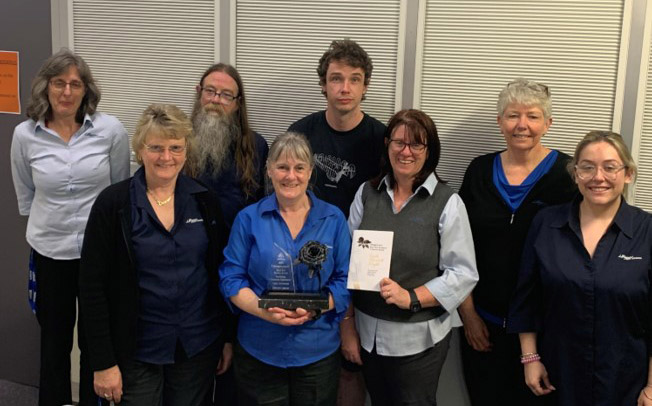May 3, 2024
Conservation groups are demanding an urgent investigation and prosecution after detecting 188 alleged breaches by Forestry Corp NSW of a new condition designed to save endangered greater gliders.
In a letter to the NSW EPA, the groups called for the EPA to issue stop work orders on active forestry operations at Flat Rock, Clyde, Currowan, Shallow Crossing, Olney, Riamukka, Styx River, Sheas Nob, and Bondo state forests after finding Forestry Corp was not complying with survey requirements for greater glider den trees.
The letter has been signed by South East Forest Rescue on behalf of the World Wide Fund for Nature-Australia, North East Forest Alliance, Wilderness Australia, North Coast Environment Council, South East Region Conservation Alliance, Nature Conservation Council of NSW, the National Parks Association of NSW, and Manyana Matters Environmental Association.
Forestry Corp is required to search for greater glider den trees and protect each tree with a 50 metre exclusion zone where logging is banned.
Identification of a den tree requires a greater glider to be seen entering or leaving a hollow.
There was outrage last year when it was revealed Forestry Corp had been conducting den tree searches during the day when greater gliders, a nocturnal species, were asleep and not entering or leaving their hollows.
On 16 February 2024, the EPA introduced condition 14 (b) which requires that searches must be carried out at night and commence no more than 1 hour after sunset.
This search window is extremely significant because research shows that greater gliders typically emerge from their hollows in the first hour after dusk to forage for eucalypt leaves.
South East Forest Rescue conducted a desktop audit of searches held after 16 February by reviewing data available on the Native Forestry Map Viewer.
After 243 transect searches, 261 gliders were sighted but only 9 den trees and 4 potential den trees were identified.
This indicates dens were only identified for 5% of gliders seen in the areas searched. The vast majority of greater glider dens were missed and not protected with the legally required 50 metre exclusion zones.
This poor result is because Forestry Corp started 188 (77%) of their searches more than an hour after dark when greater gliders had already left their dens for the night.
These searches breach the rule that transects must commence “no more than 1 hour after sunset local time”.
They were totally ineffective, as Forestry Corp did not identify a single den tree in these late night searches, some of which didn’t start until after midnight.
All the den trees that were identified were found during the 55 searches conducted within an hour of sunset.
The botched searches are even more alarming because conservation groups are already deeply concerned that the new rules only require less than 10% of the logging area to be searched for dens.
For each 100 hectares of the logging area, search transects need to be a minimum of one kilometre.
A South East Forest Rescue report, also sent to the EPA, states that in effect this means a maximum area of only 10 out of every 100 ha will be searched.
Because of detectability issues, .
The report states “After 50 years of intensive industrial scale logging the focus needs to be on the identification and protection of all glider den trees and surrounding habitat if there is to be any chance of stopping the species from going extinct”.
And that the current conditions meant to protect greater gliders “will not reverse the decline of greater gliders but entrench their pathway to extinction”.
South East Forest Rescue spokesperson Scott Daines said:
“The ink has barely dried on the new search rule and already we’ve detected nearly 200 breaches by Forestry Corp.
“Forestry Corp’s behaviour is outrageous. Once again we’re doing the EPA’s work by exposing these botched searches as time is running out to save greater gliders.
“The least the EPA can do is investigate and throw the book at Forestry Corp”.
World Wide Fund for Nature-Australia conservation scientist Dr Kita Ashman said:
“My collaborative research on the emerging times of greater gliders confirms den tree surveys should only be conducted within 1 hour of sunset, when gliders emerge, or 1 hour before sunrise when gliders return to their hollows.
“A better protection measure would be to establish a 100-metre exclusion zone around every sighting of a greater glider. This would allow surveys to be conducted through the night.
“While important, den trees do not represent the entirety of a greater glider’s habitat or behavioural needs.
“Establishing 100 metre exclusion zones would give gliders space to feed, socially interact, and safely move through habitat”.
Wilderness Australia Operations Manager Andrew Wong said:
“The Labor Party must make it clear: do they have a ‘zero extinctions’ policy and a rock solid commitment to it? If they do, this issue is where the rubber meets the road.
“Based on what we’re seeing on the ground, it seems they do not have that policy.
“Instead they have a frightening apathy towards the fate of the Southern Greater Glider. And that apathy has flowed through to the EPA, who are no longer acting as a restraining force on the logging agency Forestry Corporation of NSW, but rather have become their enabler.”
North East Forest Alliance spokesperson Dailan Pugh said:
“With identification of dens for just 5% of greater gliders found over 5-10% of the logging area, it is clear the new rules are not providing greater glider homes with the protection they need.
“If we want to save greater gliders from extinction it is essential we protect most of their dens and feed trees within their home ranges by placing 100 metre exclusions around all sightings”
Nature Conservation Council of NSW spokesperson Clancy Barnard said:
“Yet again Forestry Corporation NSW has shown itself to be a rogue operator by repeatedly flouting rules meant to protect threatened and endangered species like the iconic Greater Glider.”
“The EPA need to show they’re serious about tackling illegal logging and hold FCNSW to account by immediately issuing a Stop Work Order and investigating these breaches.”
“If the EPA doesn’t do its job and the government doesn’t commit to protecting endangered species habitat, we will we lose this precious and unique marsupial.”








